
in Thoreau’s Journal:
A cold SE wind. Blue-eyed grass ap in pretty good season.

in Thoreau’s Journal:

The common blue flag––just out at Ball’s Hill….On the meadows are large yellow-green patches of ferns beginning to prevail….Landed at a high lupine bank by Carlisle Bridge. How many such lupine banks are! Whose blue you detect rods off––
in Thoreau’s Journal:
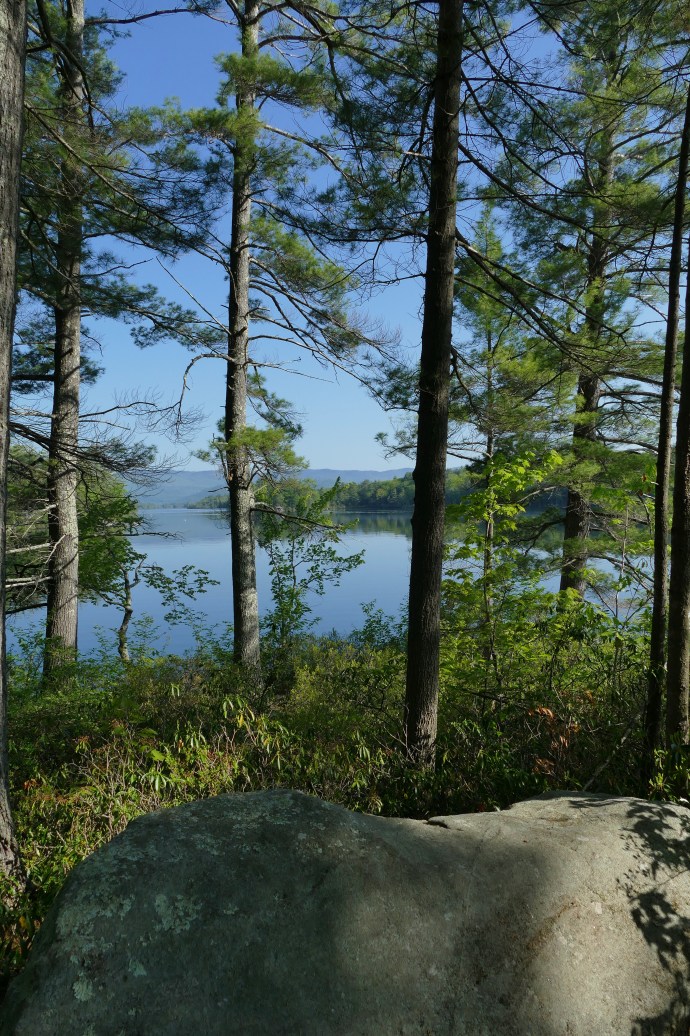
The rock feels cold to my body, as if it were a different season of the year.
in Thoreau’s Journal:
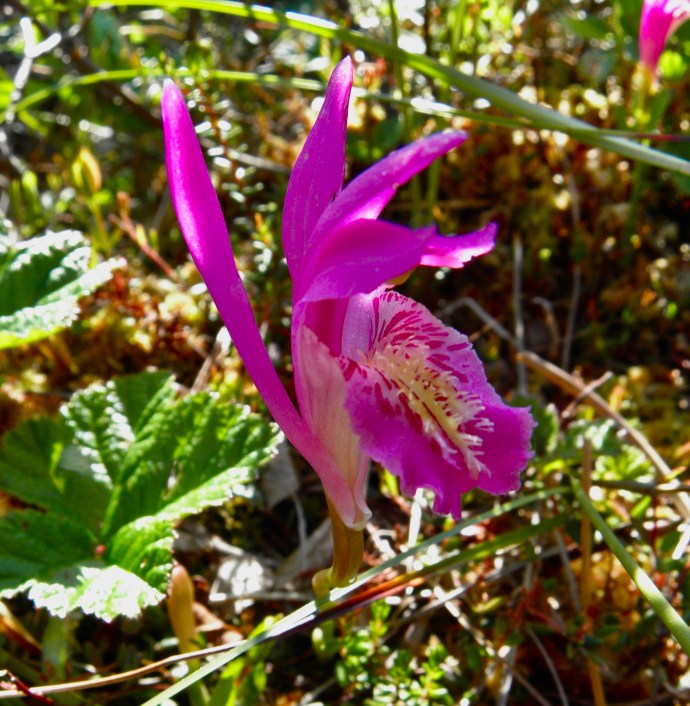
The bulbous arethusa out a day or two––prob. yesterday….Though in a measure prepared for it, still its beauty surprised me––it is by far the highest & richest color yet. Its intense color in the midst of the green meadow made it look 2ce as large as reality. It looks very foreign in the midst of our plants.––


in Thoreau’s Journal:
The fringed polygala near the Corner Spring is a delicate flower with very fresh tender green leaves & red-purple blossoms. Beautiful from the contrast of its clear red purple flowers with its clear green leaves.

in Thoreau’s Journal:
Butter cups now densely spot the church yard.
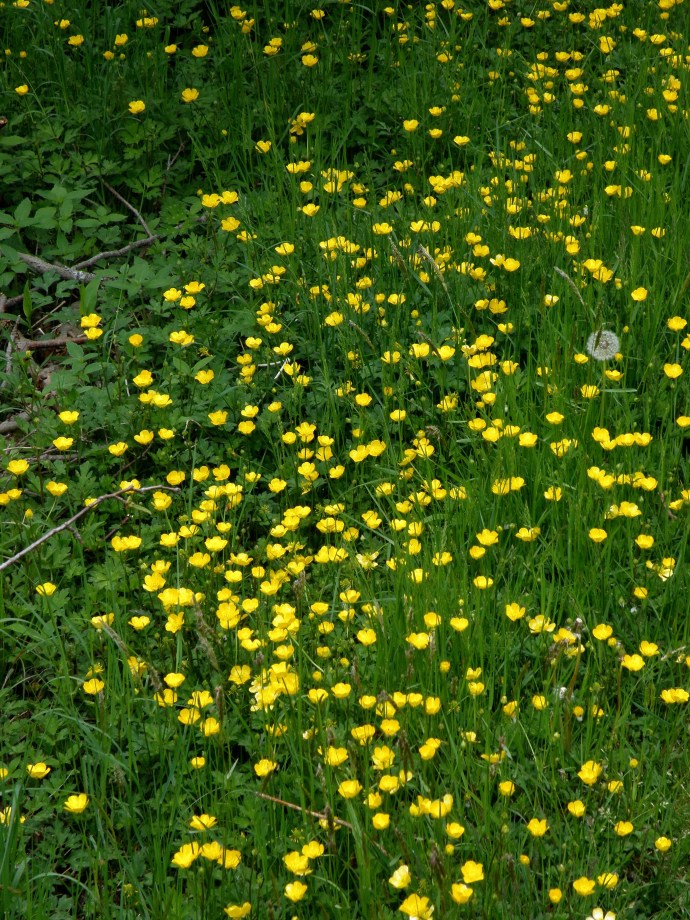

in Thoreau’s Journal:
Our most glorious experiences are a kind of regret. Our regret is so sublime that we may mistake it for triumph. It is the painful, plaintively sad surprise of our Genius remembering our past lives and contemplating what is possible.
It is remarkable that men commonly never refer to, never hint at, any crowning experience—when the common laws of their being were unsettled—and the divine & eternal laws prevailed in them. Their lives are not revolutionary—they never recognize any other than the local and temporal authorities.
It is a regret so divine & inspiring so genuine—based on so true & distinct a contrast—that it surpasses our proudest boasts and the fairest expectations.
My most sacred and memorable life is commonly on awaking in the morning—I frequently awake with an atmosphere about me as if my unremembered dreams had been divine—as if my spirit had journeyed to its native place, and in the act of reentering its native body, had diffused an elysian fragrance around.
The Genius says “Oh! That is what you were! That is what you may get be!” It is glorious for us to be able to regret even such an existence.
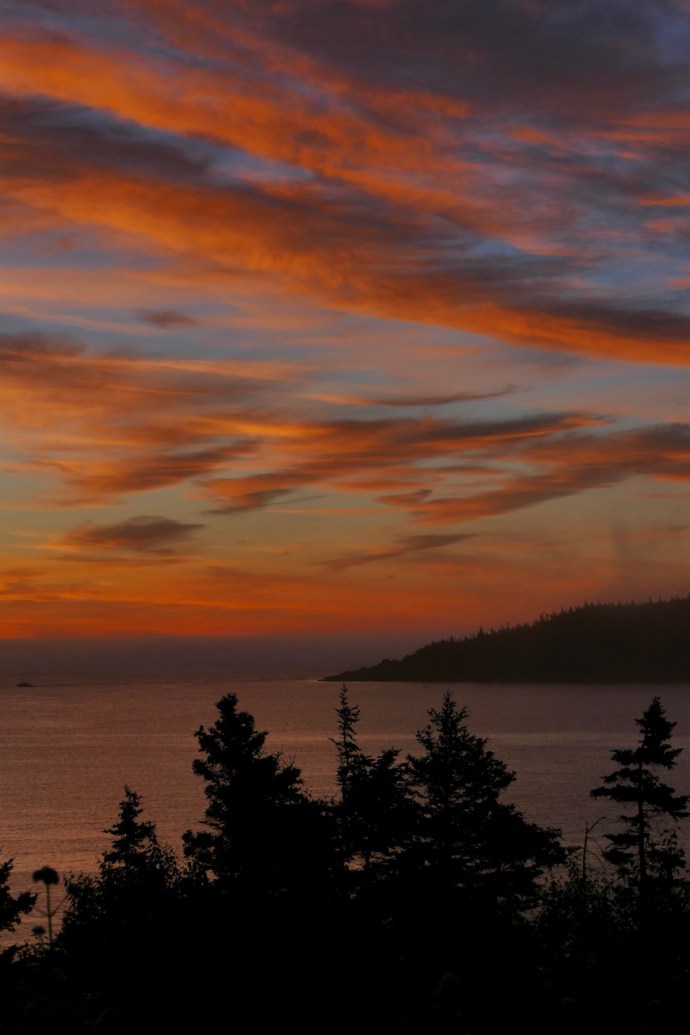
A sane & growing man revolutionises every day.
What institutions of man can survive a morning experience.
in Thoreau’s Journal:

This earth which is spread out like a map around me is but the lining of my inmost soul exposed.
in Thoreau’s Journal:
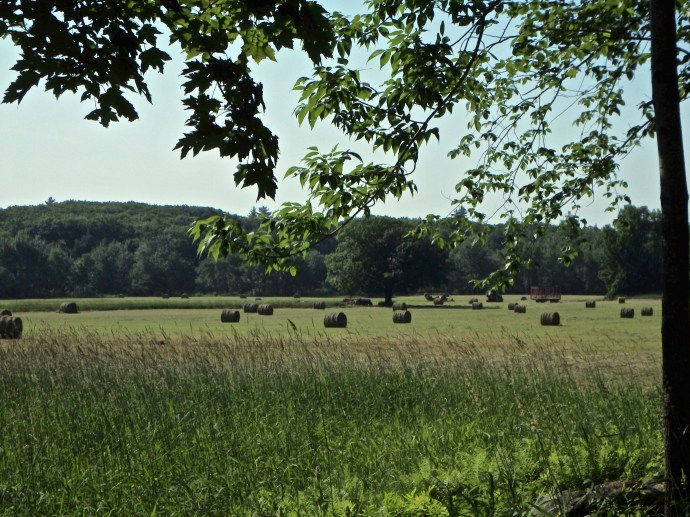
It is clear June—the first day of summer— The rye which when I last looked was 1 foot high is now 3 feet high & waving & tossing its heads in the wind— ….Why the sickle & cradle will soon be taken up. Though I walk every day—I am never prepared for this magical growth of the rye. I am advanced by whole months as it were into summer.
in Thoreau’s Journal:
The earlier apple trees are in bloom––& resound with the hum of bees of all sizes & other insects.
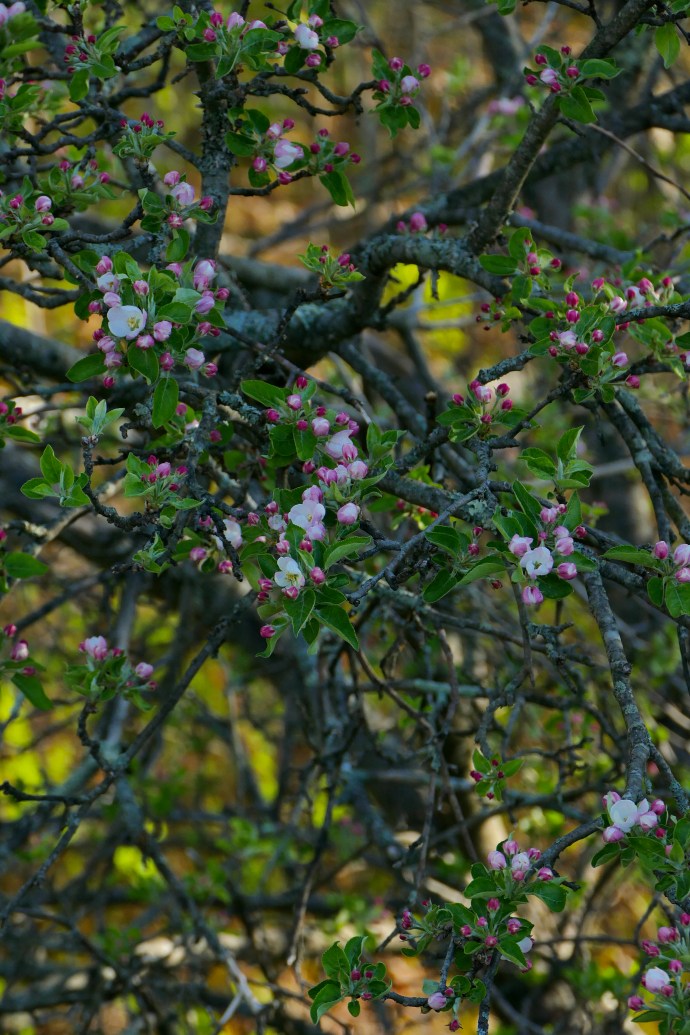
To sit under the 1st apple tree in blossom is to take another step into summer. The apple blossoms are so abundant & full––white tinged with red––a rich-scented pomona fragrance––telling of heaps of apples in the autumn––perfectly innocent wholesome & delicious––
in Thoreau’s Journal:
Now is the season of the leafing of the trees & of planting. The fields are white with houstonias, as they will soon be yellow with buttercups.

Perchance the beginning of summer may be dated from the fully formed leaves––when dense shade? begins––I will see. High blue berries at length. It is unnecessary to speak of them. All flowers are beautiful. The salix alba is about out of bloom. Pads begin to appear though the river is high over the meadows. A caterpillar’s nest on a wild cherry. Some apple trees in blossom— Most are just ready to burst forth—the leaves being half-formed. I find the fever bush in bloom but apparently its blossoms are now stale. I must observe it next year. They were fresh perhaps a week ago. Currants in bloom by Conants spring—are they natives of America? A ladies slipper well budded & now white.

The v. ovata is of a deep purple blue—is smooth &––pale blue delicately tinged with purple reflections.–– the cucullata is more decidedly blue slaty blue & darkly stained.
The white violets by the spring are rather scarce now. The red oak leaves are very pretty & finely cut about 1 3/4 inches long. Like most young leaves they are turned back around the twig parasol like. The farmers apprehend frosts these nights. A purplish gnaphallium with 3 nerved leaves.
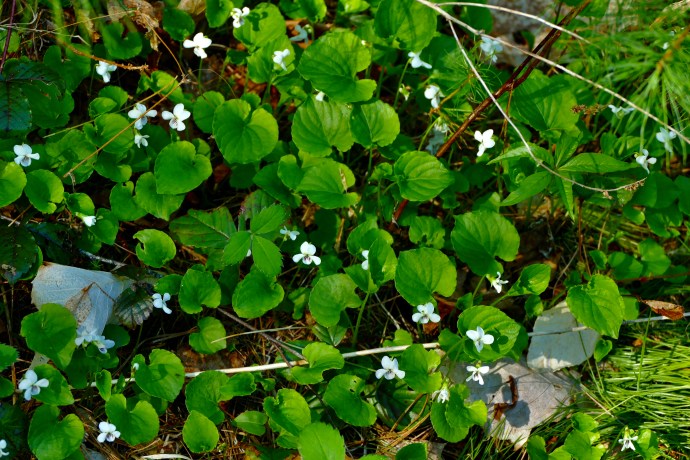
in Thoreau’s Journal:

This is the season when the meadow grass is seen waving in the wind at the same time that the shadows of clouds are passing over it.
in Thoreau’s Journal:
The shrub oaks are now blossoming. The scarlet tanagers are come.

The oak leaves of all colors are just expanding, and are more beautiful than most flowers. The hickory buds are almost leaves. The landscape has a new life and light infused into it. The deciduous trees are springing, to countenance the pines, which are evergreen. It seems to take but one summer day to fetch the summer in. The turning-point between winter and summer is reached.
in Thoreau’s Journal:
I sit now on a rock on the west slope of Fair Haven orchard, an hour before sunset, this warm, almost sultry evening, the air filled with the sweetness of apple blossoms (this is blossom week) — or I think it is mainly that meadow fragrance still — the sun partly concealed behind a low cloud in the west, the air cleared by last evening’s thunder-shower, the river now beautifully smooth (though a warm, bland breeze blows up here), full of light and reflecting the placid western sky and the dark woods which overhang it. I was surprised, on turning round, to behold the serene and everlasting beauty of the world, it was so soothing, I saw that I could not go home to supper and lose it. It was so much fairer, serener, more beautiful, than my mood had been. The fields beyond the river have unexpectedly a smooth, lawn-like beauty, and in beautiful curves sweep round the edge of the woods. The rapidly expanding foliage of the deciduous trees (last evening’s rain or moisture has started them) lights up with a lively yellow green the dark pines which we have so long been used to. Some patches (I speak of woods half a mile or more off) are a lively green, some gray or reddish-gray still, where white oaks stand. With the stillness of the air comes the stillness of the water. The sweetest singers among the birds are heard more distinctly now, as the reflections are seen more distinctly in the water — the veery constantly now. Methinks this serene, ambrosial beauty could hardly have been but for last evening’s thunder-shower, which, to be sure, barely touched us, but cleared the air and gave a start to vegetation. The elm on the opposite side of the river has now a thin but dark verdure, almost as dark as the pines, while, as I have said, the prevailing color of the deciduous woods is a light yellowish and sunny green. The woods rarely if ever present a more beautiful aspect from afar than now. Methinks the black oak at early leafing is more red than the red oak. Ah, the beauty of this last hour of the day — when a power stills the air and smooths all waters and all minds — that partakes of the light of the day and the stillness of the night!

in Thoreau’s Journal:
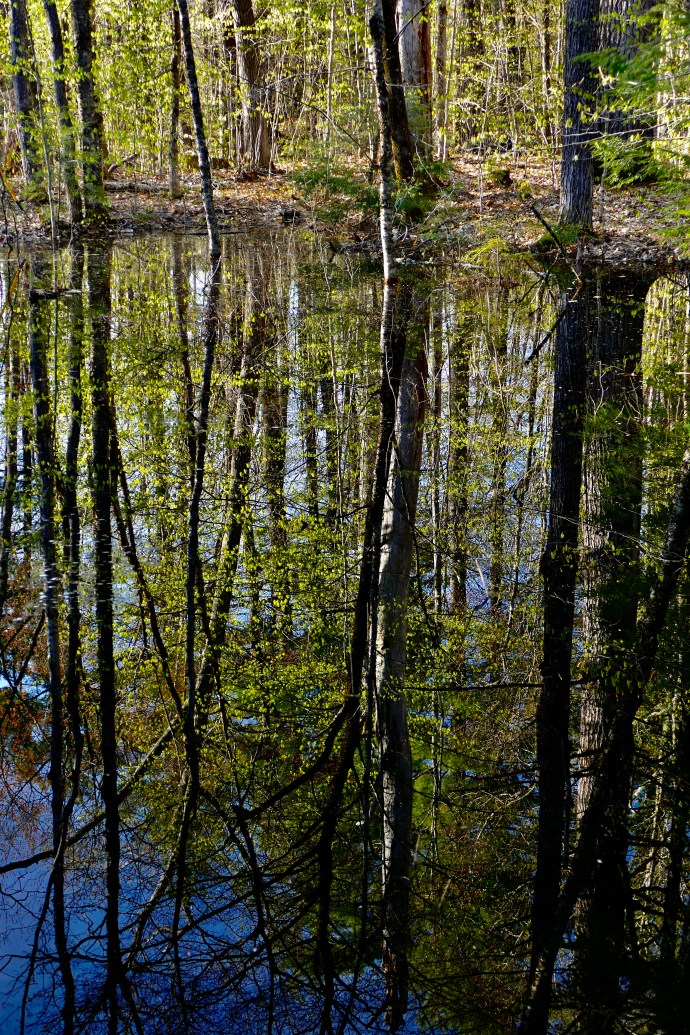
The woods putting forth new leaves; it is a memorable season. So hopeful!
in Thoreau’s Journal:

Trees generally are now bursting into leaf. The aspect of oak and other woods at a distance is somewhat like that of a very thick & reddish or yellowish mist about the evergreens— In other directions the light graceful—& more distinct yellowish green forms of birches are seen—& in swamps the reddish or reddish brown crescents of the red maple tops—now covered with keys— Oak leaves are as big as mouse ear & farmers are busy planting.
in Thoreau’s Journal:

The sounds & sights—as birds & flowers heard & seen at those seasons when there are fewest—are most memorable & suggestive of poetic associations.
in Thoreau’s Journal:
The shad blossom…a very beautiful delicate flower….with its purplish stipules & delicate drooping white blossoms— — So large & graceful a tree or bush—

The shad blossom days in the woods.

in Thoreau’s Journal:
How rarely I meet with a man who can be free, even in thought! We live according to rule. Some men are bedridden; all, world-ridden.

I take my neighbor, an intellectual man, out into the woods and invite him to take a new and absolute view of things, to empty clean out of his thoughts all institutions of men and start again; but he can’t do it, he sticks to his traditions and his crochets. He thinks that governments, colleges, newspapers, etc., are from everlasting to everlasting.
You must be logged in to post a comment.